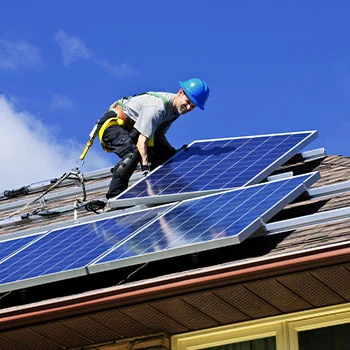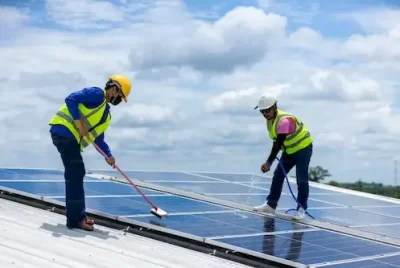Solar Power for Homes: A Guide to Residential Solar Energy Systems
We may earn a commission for purchases made using our links. See our disclosure to learn more.
A comprehensive guide on harnessing the power of the sun to generate clean, renewable energy for your home. In this article “Solar Power for Homes”, we will explore the ins and outs of solar power, discuss the components of a residential solar energy system, and provide valuable insights to help you make informed decisions.
The increasing popularity of solar power for homes can be attributed to its numerous benefits. Not only does it allow homeowners to reduce their carbon footprint and contribute to a sustainable future, but it also offers significant cost savings on electricity bills in the long run. Let’s delve into the world of residential solar energy systems and explore the steps to embrace solar power for your home.
How Solar Power Works
Solar power is harnessed by utilizing photovoltaic (PV) cells, which convert sunlight into electricity. These PV cells are typically assembled into solar panels, which are then installed on rooftops or other suitable locations to capture sunlight. The captured sunlight is then converted into usable electricity through an inverter, which transforms the direct current (DC) energy into alternating current (AC) energy compatible with home appliances and the power grid.
Assessing
Your Home’s Suitability for Solar Power
Before diving into solar power installation, it’s important to assess your home’s suitability for solar energy. Here are some key factors to consider:
1. Roof Orientation and Shading: The orientation of your roof plays a crucial role in maximizing solar energy generation. Ideally, a south-facing roof receives the most sunlight throughout the day. Additionally, shading from nearby trees or buildings can reduce the efficiency of solar panels. Assess your roof’s exposure to sunlight and ensure minimal shading for optimal performance.
2. Solar Site Assessment: Conducting a solar site assessment helps determine the solar potential of your property. A professional solar installer can evaluate your roof’s structural integrity, assess shading issues, and calculate the expected energy output based on your location and other factors. This assessment will help you make informed decisions during the solar installation process.
Choosing the Right Solar Panels
When selecting solar panels for your residential solar energy system, several factors come into play:
1. Types of Solar Panels: There are different types of solar panels available in the market, including monocrystalline, polycrystalline, and thin-film panels. Monocrystalline panels offer higher efficiency and sleek aesthetics but are relatively expensive. Polycrystalline panels are cost-effective and suitable for larger installations. Thin-film panels are flexible and can be integrated into various surfaces, but they generally have lower efficiency.
2. Efficiency and Performance: Efficiency refers to the panel’s ability to convert sunlight into electricity. Higher efficiency panels produce more electricity per square foot. Consider the efficiency ratings of different panels and choose the ones that best suit your energy needs and available space.
3. Warranty and Longevity: Solar panels come with warranties that cover manufacturing defects and performance guarantees. Look for panels with longer warranties to ensure their durability and reliability. It’s also important to consider the manufacturer’s reputation and track record.
Selecting the Appropriate Inverter
Inverters play a crucial role in converting the DC electricity generated by solar panels into usable AC electricity for your home. Here are the key types of inverters to consider:
1. String Inverters: These are the most common type of inverters used in residential solar installations. They are cost-effective and suitable for installations with minimal shading. However, the performance of the entire solar system is dependent on the efficiency of the string inverter, so shading on a single panel can affect the output of the entire string.
2. Microinverters: Microinverters are installed on each individual solar panel, allowing them to work independently. This eliminates the shading issues associated with string inverters and improves overall system efficiency. Microinverters also offer panel-level monitoring, making it easier to identify and troubleshoot any issues. However, they are usually more expensive than string inverters.
3. Power Optimizers: Power optimizers work similarly to microinverters by optimizing the performance of each panel individually. They are installed at the panel level but do not convert DC to AC directly. Instead, they condition the DC electricity before sending it to a central inverter. Power optimizers offer benefits such as panel-level monitoring and increased system efficiency.
Consider the specific requirements of your solar installation and consult with a professional to determine the most suitable inverter type for your needs.
Battery Storage for Solar Power for Homes
Integrating battery storage with your residential solar energy system offers several advantages:
1. Energy Independence: Solar batteries allow you to store excess energy generated during the day and use it during times when sunlight is limited, such as at night or during cloudy days. This reduces reliance on the grid and provides greater energy independence.
2. Backup Power during Outages: With battery storage, you can
ensure a continuous power supply to critical appliances during grid outages. In the event of a power failure, the battery system automatically kicks in, providing you with backup electricity.
3. Maximizing Self-Consumption: By storing excess solar energy, you can increase self-consumption and minimize reliance on grid electricity. This can lead to further cost savings and a more sustainable energy usage pattern.
When selecting a solar battery, consider the following:
1. Battery Type: There are different types of solar batteries, including lead-acid and lithium-ion batteries. Lithium-ion batteries are more commonly used for residential solar installations due to their higher energy density, longer lifespan, and better efficiency.
2. Capacity and Scalability: Determine your energy storage needs based on your household’s energy consumption patterns and the duration of backup power required. Consider the capacity and scalability of the battery system to ensure it meets your current and future needs.
3. Battery Management System: Opt for a battery system with an advanced battery management system (BMS) that helps optimize the performance, safety, and lifespan of the batteries.
Financing Options and Incentives
Installing a residential solar energy system requires an investment, but there are various financing options and incentives available to make it more affordable:
1. Cash Purchase: Paying upfront with cash allows you to enjoy the maximum cost savings over time. While the initial investment may be significant, it offers the quickest return on investment and eliminates any financing costs.
2. Solar Loans: Many financial institutions offer specialized solar loans with favorable terms and interest rates. These loans allow you to spread the cost of the solar installation over a period, making it more affordable.
3. Solar Leases and Power Purchase Agreements (PPAs): With solar leases and PPAs, you can lease a solar energy system or purchase the generated electricity at a predetermined rate. This eliminates the need for upfront costs but may involve long-term contracts and may not provide the same level of cost savings as ownership.
4. Government Incentives: Check for federal, state, or local government incentives, tax credits, and rebates available for solar power systems. These incentives can significantly reduce the overall cost of installation and make solar power more financially attractive.
Consult with solar installers and financial advisors to explore the best financing options and incentives available in your area.
Choosing a Reliable Solar Installer
Selecting a reputable and experienced solar installer is crucial for a successful and hassle-free installation. Here are some tips to consider:
1. Experience and Track Record: Look for installers with a proven track record in residential solar installations. Check their experience, customer reviews, and portfolio of completed projects.
2. Licenses and Certifications: Ensure the installer holds the necessary licenses and certifications required by local authorities. This ensures that the installation complies with safety and quality standards.
3. Warranties and Service: Inquire about the warranties offered by the installer for both equipment and installation work. A reliable installer should provide comprehensive warranties to protect your investment.
4. Multiple Quotes: Obtain quotes from multiple installers to compare pricing, equipment options, warranties, and services. This allows you to make an informed decision based on your specific requirements.
By choosing a reputable solar installer, you can have peace of mind knowing that your solar energy system will be installed professionally and efficiently.
Maintenance and Monitoring of Solar Systems
To ensure the optimal performance and longevity of your residential solar energy system, regular maintenance and monitoring are essential:
1. Cleaning: Keep your solar panels clean to maximize their efficiency. Regularly remove dust, debris, and any accumulated dirt that might obstruct sunlight.
2. Inspections: Schedule periodic inspections by a professional to identify any issues or potential problems with the
system. They can check for loose connections, damaged panels, or any other maintenance requirements.
3. Monitoring System: Consider installing a monitoring system that provides real-time data on your solar energy production. Monitoring allows you to track the performance of your system, detect any malfunctions or underperformance, and take necessary actions promptly.
4. Professional Servicing: Engage in a professional solar maintenance service to conduct routine inspections, cleanings, and system optimizations. They have the expertise to identify and resolve any technical issues, ensuring your system operates at its full potential.
By investing in regular maintenance and monitoring, you can maximize the energy generation of your solar system and extend its lifespan.
Overcoming Common Challenges for Solar Power for Homes
While residential solar energy systems offer numerous benefits, there are some common challenges you may encounter. Here are a few solutions:
1. Limited Roof Space: If you have limited roof space, consider installing high-efficiency solar panels or utilizing ground-mounted systems if feasible. You can also explore community solar programs that allow you to benefit from solar power without installing panels on your own property.
2. High Upfront Costs: Financing options such as solar loans or leases can help you overcome the high upfront costs. Additionally, the long-term cost savings on electricity bills and potential incentives can offset the initial investment.
3. Grid Connection: In some cases, connecting to the grid might pose challenges. Consult with your solar installer to explore options such as grid-tied systems with net metering or off-grid systems with battery storage.
Remember, every home is unique, and a customized approach is essential to address specific challenges and find the most suitable solutions.
The Environmental Benefits of Solar Power
Opting for residential solar energy systems contributes to a greener and more sustainable future:
1. Reduced Greenhouse Gas Emissions: Solar power generates clean electricity without producing harmful greenhouse gas emissions, unlike fossil fuel-based power sources. By switching to solar energy, you can significantly reduce your carbon footprint and combat climate change.
2. Decreased Dependence on Fossil Fuels: Solar power reduces reliance on fossil fuels, conserving natural resources and promoting energy independence.
3. Renewable and Sustainable Energy: Solar power is a renewable energy source, utilizing the abundant and inexhaustible power of the sun. Embracing solar energy helps create a more sustainable energy system for future generations.
By harnessing the power of the sun, residential solar energy systems have a positive impact on both the environment and our energy future.
Conclusion
Congratulations on embarking on the journey toward residential solar power! In this guide, “Solar Power for Homes”, we’ve covered the fundamentals of solar power, assessing your home’s suitability, selecting the right components, financing options, choosing a reliable installer, maintenance, and overcoming challenges. Embracing solar power for your home not only benefits the environment but also offers long-term cost savings and energy independence.
If you’re ready to make the switch, consult with reputable solar installers, explore financing options, and take advantage of available incentives. With the right planning and professional assistance, you can enjoy the benefits of clean and sustainable solar energy for years to come.
FAQs (Frequently Asked Questions)
1. Are residential solar energy systems expensive?
While the initial investment for a solar energy system can be significant, the long-term cost savings on electricity bills and potential incentives offset the upfront costs. Financing options such as solar loans and leases make solar installations more affordable.
2. What happens during a power outage with a solar energy system?
In a typical grid-tied solar system, without battery storage, the system shuts off during a power outage to protect the safety of utility workers. However, with battery storage, you can have backup power to essential appliances during outages.
3. Can I install a residential solar energy system if I live in an area with frequent cloudy days?
Yes, you can still install a residential solar energy system in areas with frequent cloudy days. While solar panels generate the most electricity under direct sunlight, they can still generate power on cloudy days. The efficiency may be slightly reduced, but your solar system will still produce electricity. Additionally, battery storage can help you store excess energy during sunny days to use during periods of limited sunlight.
4. How long do solar panels last?
Solar panels are designed to be durable and have a lifespan of around 25 to 30 years. However, their actual lifespan can vary depending on factors such as the quality of the panels, maintenance, and environmental conditions. Most manufacturers provide warranties that guarantee their performance for a certain period.
5. Can I sell excess solar energy back to the grid?
If your residential solar energy system is connected to the grid, you may have the option to sell excess energy back to the utility company. This process is known as net metering. When your solar panels generate more electricity than you consume, the excess is sent back to the grid, and you receive credits or compensation for the surplus energy. Remember to check with your local utility provider regarding their specific policies on net metering and selling back excess energy.
By following this comprehensive guide, you can confidently explore the world of residential solar power. Assess your home’s suitability, choose the right components, find the appropriate financing options, and select a reliable installer. Embrace the environmental benefits of solar power while enjoying energy independence and long-term cost savings. Start your journey towards a greener future with residential solar energy systems today!




